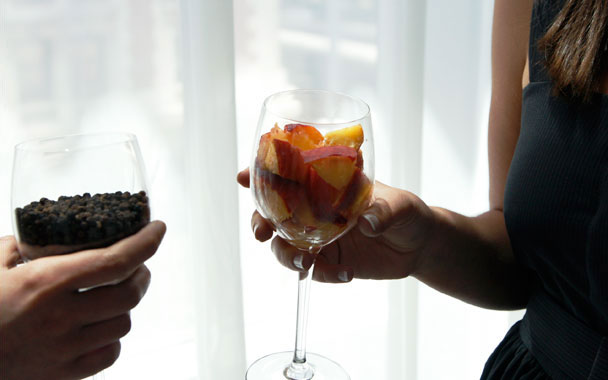I once tasted 18 gins with a bunch of perfumers. (It was for my day job, I swear.) The wine and spirits people in attendance sniffed and swirled and spat as in a wine tasting, pulling out descriptors like juniper, pepper, lime, or whatever else the scent reminded us of.
The perfumers went through the same motions but spoke a different language. “Juniperus” we could understand, as well as “ethyl alcohol,” but the rest of it sounded like a really hard class in chemistry—many words ending in “ol,” lots of “2,3,4” prefixes, and the like.
I was reminded of this recently when I read Harold McGee’s report in The New York Times that scientists had traced Syrah’s characteristic peppery aroma to the presence of rotundone, the very same chemical that gives black pepper its characteristic scent. It joins a few other common wine scents that have been traced back to a specific chemical composition, such as pyrazines, which give Cabernets as well as bell peppers their pungent green aroma, and linalool, which scents everything from Gewürztraminer to Handy Wipes with its floral-fruity essence.
It’s gratifying to find out that we’re not just making these things up. But because wine is a really complex beverage—more complex than gin, or bell peppers—we still have to make up a lot. Wine has hundreds of aroma compounds, most of which haven’t been identified in part because they change according to what other compounds are present, or in the course of winemaking. The best we can do is describe what the aroma recalls to us—thus the heavy reliance on metaphors in tasting notes.
It’s a highly personal task. My peach could be someone else’s apricot; gooseberry, a popular term in the UK, leaves most Americans scratching their heads, as it’s not a very popular fruit here. And admittedly, flavor metaphors can be abused, as tasters pile on the outlandish descriptors in a weird ploy to sound particularly perceptive. (White pomegranate, buttered peanuts, the mirabelle pâtes de fruit served at Louis XV….)
So, in a way, the idea that a single compound is responsible for a major identifying aroma in a grape is terrifically relieving: One person’s rotundone is the next person’s rotundone. Except that it’s not that easy. Although rotundone is so powerful that a single drop could make an Olympic-sized swimming pool smell of black pepper, the researchers discovered that 20 percent of the subjects tested couldn’t perceive rotundone even in huge doses.
Which just goes to show you that there is no right and wrong in wine tasting: One person’s lively, peppery Shiraz can validly be another’s soft, plummy Shiraz, rotundone or no. There’s no arguing with taste.



 Pinterest
Pinterest


